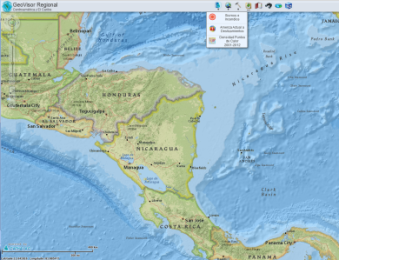The Water Center for the Humid Tropics of Latin America and the Caribbean (CATHALAC), which also hosts a UN-SPIDER Regional Support Office, has recently developed an automated, online tool for predicting landslide hazards in Mesoamerica, a first of its kind effort at the regional level. “The tool will provide early warning for landslide events in Mesoamerica, potentially minimizing the loss of life and property,” commented Emilio Sempris, CATHALAC’s Director. Mesoamerica is highly vulnerable to extreme meteorological events like flooding and to landslides that such events trigger. Decision-makers in Mesoamerica can now count on this first of its kind tool for predicting landslide hazards.
The hazard prediction uses the Mora-Vahrson methodology to determine landslide hazards at the level of detail of 1 square km. Updating itself each day, the tool indicates the potential for landslide hazards over each 24 hour window into the future, grading such potential into “very low,” “low,” “medium,” “moderate,” “high,” and “very high.” The complex modeling behind the landslide hazard prediction uses a combination of data on lithology, soil moisture, and topographic slope, along with the rainfall forecasts that CATHALAC generates daily using the PSU/NCAR mesoscale model, MM5. Following the initial implementation phase, CATHALAC will be adding enhanced functionality to the tool. The tool was also based on a prototype developed earlier, in late 2010 for Honduras and Nicaragua, in the context of the Mesoamerican Regional Visualization and Monitoring System (SERVIR), jointly implemented with the U.S. Agency for International Development (USAID), NASA, and other partners.
CATHALAC’s development of the tool follows on the footsteps of the Center’s involvement in climatologic, environmental, and geo-physical modeling over the past decade and dovetails with CATHALAC’s mission of promoting sustainable development in Latin America and the Caribbean through applied research and development, education, and technology transfer. The landslide hazard modeling depends heavily on earth observation data, and CATHALAC has likewise served as a participating organization in the inter-governmental Group on Earth Observations (GEO) since 2007.
The landslide hazard prediction tool can be accessed through CATHALAC’s Geo-Viewer (under the ”Actualidad” menu item). A version for Google Earth is also available.

